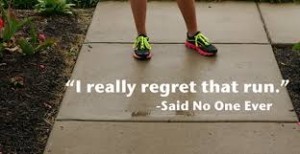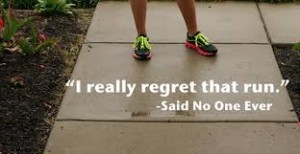If you’re new to running, guest blogger and running expert Emma Downey shares her top tips on how to get started…
By Emma Downey
If anyone has left you feeling inspired to begin running yourself then good for you!
To be successful it is important that you don’t attempt too much too soon. I often hear people say that they have become disheartened that they can’t sustain what they began or even find themselves injured and subsequently giving up.
Maybe this is even a pattern you have found yourself in before?
Give yourself credit for every run that you complete, no matter how long or how fast because running is hard work! You not only have to support your whole body weight but you also need to take into account how a sport with such high impact affects you physically.
However, having said that, running is one of the easiest sports to begin and (apart from a good pair of trainers) you don’t have the initial expense of any specialist equipment or need to join any official clubs (unless you want to). You can simply walk outside your front door and run!
Follow these beginners running tips to be a successful runner and to, above all, enjoy it!
1. Find the right pace for you
 Not knowing the right pace to begin at is probably the biggest contributing factor to people not enjoying their running and ultimately giving up. More recently many apps (such as the couch to 5k) have been hugely successful in helping people begin running. I am all in favour for anything that helps motivate people to get fit and this is definitely a great place to start if it is right for you.
Not knowing the right pace to begin at is probably the biggest contributing factor to people not enjoying their running and ultimately giving up. More recently many apps (such as the couch to 5k) have been hugely successful in helping people begin running. I am all in favour for anything that helps motivate people to get fit and this is definitely a great place to start if it is right for you.
The downside to this kind of training program is that I see an increasing amount of people underestimate their base level of fitness and are actually more active than the ‘couch’ element of these apps gives them credit for. For example, if it says ‘run for 30 seconds and walk for 30 seconds’, those with a good base level of fitness tend to sprint the 30 second run so when it comes to the week where the app advises running for 5 minutes they struggle to maintain this pace and believe they will never be able to run any further.
Before commencing any running programs (apart from ensuring you don’t have any medical reasons to consider), my advice would be to head out with the intention of seeing how long you can run at a slow and steady pace before you need to walk. From this you can begin a program at the appropriate level. If you can run for 20-30 minutes without stopping then you probably don’t need an app, just keep this pace steady and follow the advice in tip 2!
2. Build up your training slowly
Whilst pace is the main reason people give up running, increasing how far you run too quickly is probably the biggest contributor to injuries. Here are three of the the most common running injuries that I see:
‘Runners knee’ – a pain on the lateral side (outside) of the knee, either level with or just below the patella (knee cap). This is caused by the IT Band being put under too much tension and transferring this to the  insertion point (around the point of pain). The IT Band comes under increasing tension when the glutes, particularly glute medius, is not yet strong enough to cope with the intensity of running.
insertion point (around the point of pain). The IT Band comes under increasing tension when the glutes, particularly glute medius, is not yet strong enough to cope with the intensity of running.
‘Shin splints’ – Also known as tibial stress syndrome, is a generic term for anterior lower leg pain. It can cause pain at any point down the medial (inside) or lateral side of the tibia (shin bone) and is usually caused by a tightness in the calf muscles putting increased strain on the tendons and/or connective tissues. One of the contributing factors to this injury is building up the minutes/mileage too quickly and putting extra strain on weak/unconditioned muscles.
‘Plantar fasciitis’ – The plantar fascia is a connective tissue that supports the arch of the foot, running from the heel of the foot to the toes. Plantar fasciitis is when this connective tissue becomes tight and sometimes inflamed from over or improper use and is often caused by tightness in the calf muscles and/or weakness in the glutes – both contributed to by increasing training beyond the capability of the muscles.
My advice is increase your training by no more than 10% per week, for example, if you are running for 20 minutes in a session one week then you would look to run for no more than 22 minutes in that session the next week. This is based on the assumption that you are running 2-3 times a week. Any less then I would advise increasing by 10% every 2-3 weeks. Similarly, if you are running 2-3 times a week then it is a good idea to mix up your distances so you’re not running to your maximum too frequently.
3. Stretch after every session
When I first began running at the tender age of 11, we were taught to warm up and stretch before every session and then cool down and stretch at the end of every session. Being a sprinter back then it was imperative that I warmed up properly due to the range of movement that I was asking my muscles to perform.
Nowadays I am not so worried about doing a specific warm up unless I’m looking for a time, e.g. pre race, or before a speed session where I will be using a fuller range of movement to my usual running. Even in these cases it is nowhere near as intense as the warm ups I was used to as a youngster and includes dynamic movements rather than static stretches.
 Cool down stretches, however, are a completely different matter. These are very important as they help my muscles regain their pre-run state which then allows me to begin my next run in the best condition possible. My clients will vouch that I am always emphasising how important stretching is yet many people don’t do enough of it!
Cool down stretches, however, are a completely different matter. These are very important as they help my muscles regain their pre-run state which then allows me to begin my next run in the best condition possible. My clients will vouch that I am always emphasising how important stretching is yet many people don’t do enough of it!
Cool down stretches, as a minimum, should include all the main muscle groups used for running (quads, hamstrings, calves, glutes and hip flexors) and be held for 15-30 seconds. Once a week or fortnight, I would recommend doing a longer stretch session where you include upper body stretches (lower back, upper back, chest, neck and shoulders) and hold each stretch for 30 seconds and repeating each stretch twice.
4. Get yourself some properly fitted trainers
 You could argue that this should be the first thing you do, but if you find you really don’t get on with running then you will be pretty annoyed at having spent £50-£100 on a good pair of trainers. However, having said that, getting a pair of trainers fitted specifically to you will be one of the best investments you will make as a runner.
You could argue that this should be the first thing you do, but if you find you really don’t get on with running then you will be pretty annoyed at having spent £50-£100 on a good pair of trainers. However, having said that, getting a pair of trainers fitted specifically to you will be one of the best investments you will make as a runner.
There are several places that will assess your biomechanical movement (gait and joint alignment) and offer you a trainer to support you and your running style but Gen and I personally recommend (and use ourselves) Alton Sports (also/previously known as Just Run in Eastleigh) I often suggest them to clients as they have given me good advice on other products in the past. Clients of Gen’s also get a discount off trainers!
Although all these places have an online shop, I would highly recommend you visit one of their high street shops for a full assessment so you know you are getting the best trainers for you. There are countless types of trainer – supported, neutral, cushioned, minimalist to name a few – and probably even more different views and opinions on which is better for you, but the trained staff in these shops can give you very personal advice.
5. Run with a friend
 This one is by no means compulsory but provides some much needed encouragement, especially if you are having difficulty finding the motivation by yourself. Knowing you have arranged to meet someone and not wanting to let them down means it is more likely that you will do the planned run.
This one is by no means compulsory but provides some much needed encouragement, especially if you are having difficulty finding the motivation by yourself. Knowing you have arranged to meet someone and not wanting to let them down means it is more likely that you will do the planned run.
We are all naturally competitive (some more than others), even if it is just with ourselves, so running with a friend helps you push each other on – particularly helpful if one of you is having ‘one of those days’ and needs dragging round for a bit!
 However, some people do prefer to run by themselves and maybe choose to listen to music to keep them going rather than run with someone else. Whichever type of runner you are, find a method that works for you to keep you motivated and looking forward to your next run. If you are on Facebook, a great motivational group to join is Running The World – a truly wonderful group of people full of advice and motivation on many different subjects from helping you run your first mile to finishing your first marathon.
However, some people do prefer to run by themselves and maybe choose to listen to music to keep them going rather than run with someone else. Whichever type of runner you are, find a method that works for you to keep you motivated and looking forward to your next run. If you are on Facebook, a great motivational group to join is Running The World – a truly wonderful group of people full of advice and motivation on many different subjects from helping you run your first mile to finishing your first marathon.
As you increase and improve your running you might think about entering an event. You may look at joining a club where you will do a variety of speed and endurance sessions, possibly over different terrains. As you become more experienced you will probably look at getting a timing/GPS device and may even embark on getting the odd sports massage combined with some running specific strength training sessions!
Wherever your journey takes you I would love to hear your story so please feel free to let me know how you’re getting on ![]()
Thanks Emma for such a great article! I hope you have found it as useful as I have and wish you every success in your running adventures!


